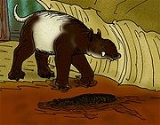
Trigonostylops
Encyclopedia
Trigonostylops is an extinct genus of South American ungulate
, from the late Paleocene
to early Eocene
of Argentina
.
A complete skull
of the type species
, T. wortmani, has been found, and it has been classified as an astrapothere based on its large lower tusks. In comparison with the later Astrapotherium magnum
, it is estimated to have been around 1.50 m (5 ft) long. Teeth, primarily molar
s, have been found and assigned to other species.
Ungulate
Ungulates are several groups of mammals, most of which use the tips of their toes, usually hoofed, to sustain their whole body weight while moving. They make up several orders of mammals, of which six to eight survive...
, from the late Paleocene
Paleocene
The Paleocene or Palaeocene, the "early recent", is a geologic epoch that lasted from about . It is the first epoch of the Palaeogene Period in the modern Cenozoic Era...
to early Eocene
Eocene
The Eocene Epoch, lasting from about 56 to 34 million years ago , is a major division of the geologic timescale and the second epoch of the Paleogene Period in the Cenozoic Era. The Eocene spans the time from the end of the Palaeocene Epoch to the beginning of the Oligocene Epoch. The start of the...
of Argentina
Argentina
Argentina , officially the Argentine Republic , is the second largest country in South America by land area, after Brazil. It is constituted as a federation of 23 provinces and an autonomous city, Buenos Aires...
.
A complete skull
Skull
The skull is a bony structure in the head of many animals that supports the structures of the face and forms a cavity for the brain.The skull is composed of two parts: the cranium and the mandible. A skull without a mandible is only a cranium. Animals that have skulls are called craniates...
of the type species
Type species
In biological nomenclature, a type species is both a concept and a practical system which is used in the classification and nomenclature of animals and plants. The value of a "type species" lies in the fact that it makes clear what is meant by a particular genus name. A type species is the species...
, T. wortmani, has been found, and it has been classified as an astrapothere based on its large lower tusks. In comparison with the later Astrapotherium magnum
Astrapotherium magnum
Astrapotherium magnum is an extinct South American mammal which vaguely resembled a cross between a small elephant, and a very large tapir. It may have fed on marsh plants...
, it is estimated to have been around 1.50 m (5 ft) long. Teeth, primarily molar
Molar (tooth)
Molars are the rearmost and most complicated kind of tooth in most mammals. In many mammals they grind food; hence the Latin name mola, "millstone"....
s, have been found and assigned to other species.

